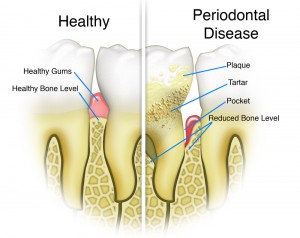Periodontal disease, often just called “gum disease,” can be the source of a person’s breath problems, but it can also be much more serious. Periodontal diseases are bacterial infections that affect the gums, bone and ligaments that attach teeth to bone. Gum disease has been described by the US Surgeon General as a silent epidemic, affecting approximately 85 percent of American adults thirty-five and over.
The disease starts with an inflammatory response to a bacterial infection in the gum tissue. Gum disease is not only the leading cause of adult tooth loss but has also been linked to heart disease, diabetes, upper respiratory disease and other inflammatory infections. Periodontal disease may be BOTH a symptom and a contributing factor in Type 2 diabetes. While many people think plaque and tartar are simply an aesthetic liability, plaque bacteria threatens your teeth, gums, restorative and cosmetic work; possibly even your life.
Plaque is transferred to the teeth when you choose to eat foods that contain a lot of starch or sugar. Bacteria found in plaque produces toxins or poisons that irritate the gums, which may cause them to turn red, swell and bleed easily. Bacterial plaque – a sticky, colorless film that constantly forms on the teeth – is recognized as the primary cause of gum disease.
Dr. Elmira Abraamyan of Sunrise Family Dentistry in Roseville, CA says, “Once an individual is diagnosed with gum disease, the standard treatment available involves intensive cleaning of the teeth above and below the gum line.” This is a repetitive practice (every 3 to 6 months) that often requires a local anesthetic. Severe cases may require surgery, but many patients leave their disease untreated and therefore lose their teeth.
To keep your teeth and gums healthy, it is important to floss daily and brush at least twice a day with a soft or electric toothbrush. Good dental hygiene at home and regular dental cleanings help maintain above and below the gum line free of plaque and tartar.
This way you prevent problems such as gum recession, cavities, bone loss and eventual tooth loss. Because gum disease is silent, many people who ignore it or are unaware that they have the disease end up losing teeth and have no other choice but to wear dentures.


